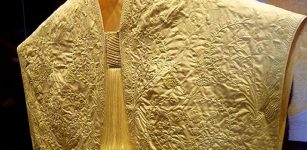Shinobi No Mono: The Shadow Warriors And Hattori ‘The Demon’ Hanzo Of Ancient Japan
Ellen Lloyd - AncientPages.com - Led by Hattori "the Demon" Hanzo, Shinobi no Mono, the Shadow Warriors of the 16th century were incredible ancient Japanese fighters who became known for their seemingly superhuman power and astonishing athletic accomplishments.
Credit: Adobe Stock - breakermaximus
The Shinobi Shadow Warriors were masters in becoming almost invisible through masterful stealth. One of their many helpful fighting skills was to avoid detection. Many credited these fighters with supernatural powers, and it was said that it was already too late to escape if you spotted a Shadow Warrior.
Today, the Shinobi no Mono and the Shadow Warriors are recognized as Ninjas.
In Japanese, the words "nin" and Wshinobi" have the same meaning: "stealth" or "quiet action." The words also mean "to endure." Meanwhile, "sha" and "mono" both mean "person." So a simple translation would be "a person skilled in the art of stealth."
In modern times, Ninjas are regarded as assassins, but historically, the Ninja played an entirely different role. Ninjas were often spies, scouts, and commando-type covert operation forces.
Credit: Adobe Stock - sheikoevgeniya
In 1562 A.D., Japan was a war-like zone. Ongoing civil wars that lasted more than 100 years devastated the country and its people.
Hattori' The Demon' Hanzo Of Ancient Japan
Tokugawa Ieyasu, an ambitious warlord, became the founder and first shogun of the Tokugawa shogunate of Japan, which virtually ruled Japan from the Battle of Sekigahara in 1600 until the Meiji Restoration in 1868.
Tokugawa Ieyasu used several skilled warriors to win battles and strengthen his military power. One of them was Hattori Hanzo (1542-1596), one of the greatest Ninjas of all time.
Hanzo Hattori began his training by climbing a mountain at eight and seeking instruction from the most hardcore ninja masters in Japan. When he was 16, he earned the nicknames "Hanzo the Ghost" and "Devil Hanzo" because of his skills to sneak up on enemies without being seen or heard.
Hanzo made a successful hostage rescue of Tokugawa's daughters in Kaminogo Castle in 1562 and went on to lay siege to Kakegawa Castle in 1569.
He became famous for unconventional warfare. He became the leader of the most elite fighting group in the Japanese world and trained his fighters in the secret martial art of Shinobi.
The Shadow Warriors And Their "Magical Powers"
The Shadow Warriors, trained by Hanzo Hattori, possessed magical powers. Hanzo himself was often attributed to supernatural abilities such as psychokinesis and precognition.
The shinobi, or ninja, is one of the most widely recognized figures in the world of espionage—and also one of the most misrepresented. What do we really know about the historical shinobi, his tactics, and his role in medieval Japanese society? In Secret Traditions of the Shinobi, these questions—and many more—are answered. Translated into English for the very first time, this widely sought-after collection of historical documents brings to light the secret practices, techniques, philosophies, and lifestyles of the shinobi. Read more
The Shinobi, or Ninja, is one of the most widely recognized figures in the world of espionage and one of the most misrepresented. What do we know about the historical Shinobi, his tactics, and his role in medieval Japanese society? In Secret Traditions of the Shinobi, these questions—and many more—are answered. Translated into English for the first time, this widely sought-after collection of historical documents brings to light the Shinobi's secret practices, techniques, philosophies, and lifestyles. Read more
The truth is that these warriors employed unusual military tactics. They could move undetected and vanish without a trace. It was one of the reasons why the Shadow Warriors were predominantly used for commando infiltration raids and information and intelligence gathering. They were considered ancient Japan's most effective resources for espionage.
Shinobi Warriors never infiltrated during the full moon due to the excessive light it reflects off the Sun during the nighttime hours. Instead, they preferred to enter either eight days before or after the full moon when optimal darkness was available. In this style of approach, the Ninja is nearly invisible in his black Shinobi gear.
A portrait of Hanzō Hattori from the 17th century. Unknown - Public Domain
After his death on 4 November 1596, Hattori Hanzo was succeeded by his son, whose name was also Masanari, though written with different kanji. He was given the title of Iwami no Kami, and his Iga Ninjas would act as guards of Edo Castle, the headquarters of the government of united Japan.
The memory of Hattori Hanzon is still very much alive. Tokyo Imperial Palace, which was earlier the shogun's palace, still has a gate called Hanzo's Gate (Hanzomon). The Hanzomon subway line from Hanzomon Station in central Tokyo to the southwestern suburbs is named after the entrance where his house was once located.
Updated on January 16, 2024
Written by Ellen Lloyd – AncientPages.com
Copyright © AncientPages.com All rights reserved. This material may not be published, broadcast, rewritten or redistributed in whole or part without the express written permission of AncientPages.com
Expand for referencesReferences:
Joel Levy - Ninja: The Shadow Warrior
More From Ancient Pages
-
 A Large ‘Tableman’ Sheds Some Light On People’s Fun And Games In Medieval Bedfordshire
Archaeology | Jun 19, 2023
A Large ‘Tableman’ Sheds Some Light On People’s Fun And Games In Medieval Bedfordshire
Archaeology | Jun 19, 2023 -
 Impressive And Rare Hoard Of Silver Coins Dated To The Hasmonean Period (126 BC) – Studied
Archaeology | Oct 14, 2021
Impressive And Rare Hoard Of Silver Coins Dated To The Hasmonean Period (126 BC) – Studied
Archaeology | Oct 14, 2021 -
 Magnificent Golden Silk Cloth Made By 1 Million Spiders Is One Of The World’s Rarest Silk Textiles
Artifacts | May 20, 2021
Magnificent Golden Silk Cloth Made By 1 Million Spiders Is One Of The World’s Rarest Silk Textiles
Artifacts | May 20, 2021 -
 Dionysus – Greek God Of Wine, Music, Ritual Madness And Ecstasy Was Born Twice
Featured Stories | Jan 8, 2019
Dionysus – Greek God Of Wine, Music, Ritual Madness And Ecstasy Was Born Twice
Featured Stories | Jan 8, 2019 -
 5,000-Year-Old Underground Partly Submerged City Discovered In Turkey’s Cappadocia
Archaeology | Jun 10, 2019
5,000-Year-Old Underground Partly Submerged City Discovered In Turkey’s Cappadocia
Archaeology | Jun 10, 2019 -
 Thousands Of Sacred ‘Images’ With Unknown Signs Hidden In A Monastery Could Be World’s Oldest Alphabet
Ancient Mysteries | Jun 9, 2021
Thousands Of Sacred ‘Images’ With Unknown Signs Hidden In A Monastery Could Be World’s Oldest Alphabet
Ancient Mysteries | Jun 9, 2021 -
 48,000-Year-Old Tooth That Belonged To Neanderthal Child Found In Northern Italy
Fossils | Sep 19, 2020
48,000-Year-Old Tooth That Belonged To Neanderthal Child Found In Northern Italy
Fossils | Sep 19, 2020 -
 First People To Enter The Americas Brought Their Dogs With Them
Archaeology | Jan 29, 2021
First People To Enter The Americas Brought Their Dogs With Them
Archaeology | Jan 29, 2021 -
 Mahabalipuram: Ancient Ruined City And Its Marvellous Rock-Cut Architecture In South India
Featured Stories | Jul 25, 2021
Mahabalipuram: Ancient Ruined City And Its Marvellous Rock-Cut Architecture In South India
Featured Stories | Jul 25, 2021 -
 Secret Passageways And Caves Beneath UK’s City Of Nottingham
Featured Stories | Feb 14, 2023
Secret Passageways And Caves Beneath UK’s City Of Nottingham
Featured Stories | Feb 14, 2023 -
 Ancient City Filled With Treasures May Be Hidden Underground In South America
Ancient Mysteries | Jul 20, 2018
Ancient City Filled With Treasures May Be Hidden Underground In South America
Ancient Mysteries | Jul 20, 2018 -
 Unsolved Mystery Of The Aleppo Codex And Its Missing Pages: One Of The World’s Most Precious Ancient Books
Ancient Mysteries | Feb 27, 2017
Unsolved Mystery Of The Aleppo Codex And Its Missing Pages: One Of The World’s Most Precious Ancient Books
Ancient Mysteries | Feb 27, 2017 -
 Mictlan – Underworld Realm Of The Dead In Ancient Aztec Beliefs
Aztec Mythology | Jul 2, 2018
Mictlan – Underworld Realm Of The Dead In Ancient Aztec Beliefs
Aztec Mythology | Jul 2, 2018 -
 Venus Cloacina: Roman Goddess Of Sewers And Drains
Featured Stories | Dec 19, 2019
Venus Cloacina: Roman Goddess Of Sewers And Drains
Featured Stories | Dec 19, 2019 -
 Stone Age Statues Were Taken To Britain For Restoration In 1990 – Never Returned Home To Jordan
News | Apr 6, 2021
Stone Age Statues Were Taken To Britain For Restoration In 1990 – Never Returned Home To Jordan
News | Apr 6, 2021 -
 Unraveling The Secret History Of King Arthur And Robin Hood
Featured Stories | Jul 14, 2015
Unraveling The Secret History Of King Arthur And Robin Hood
Featured Stories | Jul 14, 2015 -
 Was A Statue Of Asherah Hidden In The Ark Of The Covenant?
Artifacts | Dec 26, 2017
Was A Statue Of Asherah Hidden In The Ark Of The Covenant?
Artifacts | Dec 26, 2017 -
 Secrets Of An Unusual And Mysterious Medieval Danish Axe Revealed By Scientist
Archaeology | Nov 25, 2022
Secrets Of An Unusual And Mysterious Medieval Danish Axe Revealed By Scientist
Archaeology | Nov 25, 2022 -
 ‘Flower Burial’ And Shanidar Cave With Neanderthal Remains Who Lived 70,000 Years Ago
Archaeology | Feb 19, 2020
‘Flower Burial’ And Shanidar Cave With Neanderthal Remains Who Lived 70,000 Years Ago
Archaeology | Feb 19, 2020 -
 Was Pocahontas A Real Historical Person?
Featured Stories | Feb 20, 2019
Was Pocahontas A Real Historical Person?
Featured Stories | Feb 20, 2019




